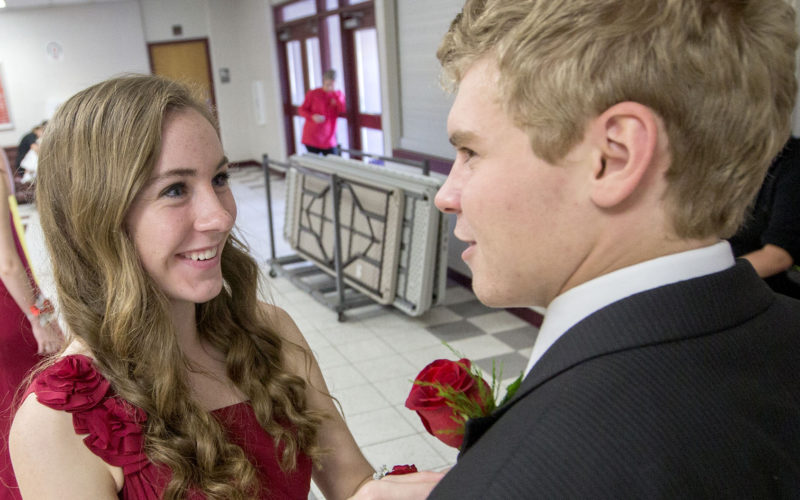Q. I was wondering about boutonnieres. I have always thought it is a fun look, but wonder if it is in style or ever was. I have two weddings coming up, one where I’m in the wedding party, and one not. Is a flower only appropriate in the first? If both, can I ever wear one on a “non-event” suit?
A. Wearing a boutonniere is a style that has come and gone, but has never completely disappeared. It need not be reserved for attending weddings, the opera, or proms.
To begin, we should explain just what a boutonniere is. It is a man’s accessory, a single, fresh flower that is worn in his lapel. It should be worn with dress wear–formal or business–that is a jacket and tie, not with casual attire. And, indeed, you are right, it is a fun look, but it was much more in style awhile back than it is today. Still, for a man who is comfortable with this dapper look, it can be a fine way to make a fashion statement when it is done right, and in the right setting.
Historically, it is believed to have begun as a way of identifying oneself on the field of battle, with different flowers indicating different allegiances. This was important in the civil wars of England, where both sides would have looked a lot alike. Another reason for wearing flowers was that the special properties of some flowers were thought to protect the wearer from disease, and, perhaps more importantly, to protect him from evil.
Today, the boutonniere is strictly an accessory. While women may use pins on their lapels instead of a boutonniere, men can only wear a pocket handkerchief or a union/flag/political/etc. pin as a lapel accessory. The trick is to wear that accessory in an elegant way that enhances a man’s smart appearance, and does not make him look foolish.
These days, formal and very dressy events are usually the only times when a man wears a boutonniere. However, the actual rules for when to wear them are not restricted to such occasions. They can be worn for the many times when you are dressing up a bit (and for events where “festive attire” is suggested) – not only for very special ones. Years ago, when I was doing research for my book and working in the Men’s Department of Neiman-Marcus, a gentleman who worked with me wore one every day to work. It was his signature. Of course, he wore it correctly.
What constitutes wearing it correctly? What would be wrong? In other words, what defines wearing one well? Four elements: the person wearing it; the event/environment where it is worn; the rest of the clothes with which it is being worn; how it is worn.
The person wearing it must be a man who is a rather elegant dresser, who is comfortable wearing something that makes him stand apart from the crowd, and who wants to personalize a dapper appearance. It is important to realize that a boutonniere might seem out of place in some industries; for example, in Silicon Valley. But if you are in entertainment or fashion, it could certainly be appropriate. And to repeat what I have written in the past, the wearer should be a clothing-aware guy who knows not to add any other attention-grabbing accessories along with his boutonniere . . . perhaps only a quiet pocket square or simple cuff links, but nothing else.
The event/environment where it is worn should be something a lot more special than shooting baskets in the driveway, but it need not be a formal occasion. A man can pick and choose when to wear it; it does not need to be a consistent, everyday part of his dressing style.
The rest of the clothes the man is wearing should fit logically with the dapper effect of the flower. It is not logical with jeans, shorts, or anything else that is super casual. Oddly enough, the color of the boutonniere does not need to match or coordinate with the other clothes you are wearing. While I would avoid an outright clashing of colors (such as an orange flower with a pink shirt), it is enough merely to choose a small, perfect bloom. And, it is my strong opinion that it should be real; I believe a fake flower reeks of nouveau riche inexperience.
What it is composed of and how it is worn. The best flowers for boutonnieres are single roses, bachelor buttons, and carnations. This is true except for the groom at his wedding; his boutonniere is supposed to be a flower plucked from the bride’s bouquet – as an example, a few sprigs of lily-of-the-valley. The ideal way to wear a boutonniere is pushed through an actual buttonhole on the jacket’s lapel. Upscale suits have this and also a small thread loop on the underside of the lapel to hold the stem in place. Jackets without this feature require florist pins to hold it. Be sure the pins are under the lapel and do not show.
To sum up, you don’t need to be in a wedding party to wear a boutonniere. If it suits your personality to stand out, if you are wearing it where it makes sense, and if you like the look, don’t hesitate to try one on your lapel.
Please send your men’s dress and grooming questions and comments to MALE CALL: Lois.Fenton@prodigy.net









